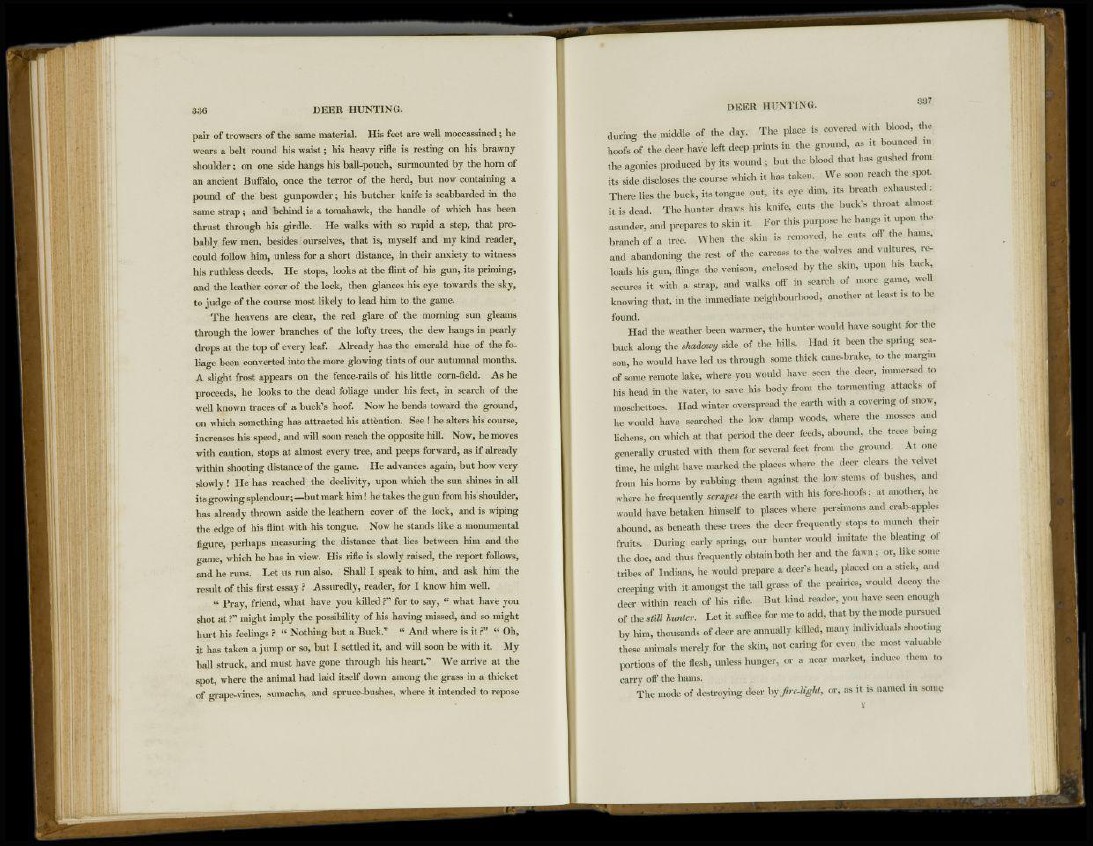
336 DEER HUNTING.
pair of trowsers of the same material. His feet are well moccassined; he
wears a belt round his waist; his heavy rifle is resting on his brawny
shoulder; on one side hangs his ball-pouch, surmounted by the horn of
an ancient Buffalo, once the terror of the herd, but now containing a
pound of the best gunpowder; his butcher knife is scabbarded in the
same strap; and behind is a tomahawk, the handle of which has been
thrust through his girdle. He walks with so rapid a step, that probably
few men, besides ourselves, that is, myself and my kind reader,
could follow him, unless for a short distance, in their anxiety to witness
his ruthless deeds. He stops, looks at the flint of his gun, its priming,
and the leather cover of the lock, then glances his eye towards the sky,
to judge of the course most likely to lead him to the game.
The heavens are clear, the red glare of the morning sun gleams
through the lower branches of the lofty trees, the dew hangs in pearly
drops at the top of every leaf. Already has the emerald hue of the foliage
been converted into the more glowing tints of our autumnal months.
A slight frost appears on the fence-rails of his little corn-field. As he
proceeds, he looks to the dead foliage under his feet, in search of the
well known traces of a buck's hoof. Now he bends toward the ground,
on which something has attracted his attention. See ! he alters his course,
increases his speed, and will soon reach the opposite hill. Now, he moves
with caution, stops at almost every tree, and peeps forward, as if already
within shooting distance of the game. He advances again, but how very
slowly ! He has reached the declivity, upon which the sun shines in all
its growing splendour;—but mark him! he takes the gun from his shoulder,
has already thrown aside the leathern cover of the lock, and is wiping
the edge of his flint with his tongue. Now he stands like a monumental
figure, perhaps measuring the distance that lies between him and the
game, which he has in view. His rifle is slowly raised, the report follows,
and he runs. Let us run also. Shall I speak to him, and ask him the
result of this first essay ? Assuredly, reader, for I know him well.
" Pray, friend, what have you killed ?" for to say, " what have you
shot at ?" might imply the possibility of his having missed, and so might
hurt his feelings ? " Nothing but a Buck." " And where is it?" " Oh,
it has taken a jump or so, but I settled it, and will soon be with it. My
ball struck, and must have gone through his heart."" We arrive at the
spot, where the animal had laid itself down among the grass in a thicket
of grape-^-ines, sumachs, and spruce-bushes, where it intended to repose
DEER HUNTING. 337
during the middle of the day. The place is covered with blood, the
hoofs of the deer have left deep prints in the ground, as it bounced in
the agonies produced by its wound ; but the blood that has gushed from
its side discloses the course which it has taken. We soon reach the spot.
There lies the buck, its tongue out, its eye dim, its breath exhausted :
it is dead. The hunter draws his knife, cuts the buck's throat almost
asunder, and prepares to skin it. For this purpose he hangs it upon the
branch of a tree. When the skin is removed, he cuts off the hams,
and abandoning the rest of the carcass to the wolves and vultures, reloads
his gun, flings the venison, enclosed by the skin, upon his back,
secures it with a strap, and walks off in search of more game, well
knowing that, in the immediate neighbourhood, another at least is to be
found.
Had the weather been warmer, the hunter would have sought for the
buck along the shadowy side of the hills. Had it been the spring season,
he would have led us through some thick cane-brake, to the margin
of some remote lake, where you would have seen the deer, immersed to
his head in the water, to save his body from the tormenting attacks of
moschettoes. Had winter overspread the earth with a covering of snow,
he would have searched the low damp woods, where the mosses and
lichens, on which at that period the deer feeds, abound, the trees being
generally crusted with them for several feet from the ground. At one
time, he might have marked the places where the deer clears the velvet
from his horns by rubbing them against the low stems of bushes, and
where he frequently scrapes the earth with his fore-hoofs; at another, he
would have betaken himself to places where persimons and crab-apples
abound, as beneath these trees the deer frequently stops to munch their
fruits. During early spring, our hunter would imitate the bleating of
the doe, and thus frequently obtain both her and the fawn ; or, like some
tribes of Indians, he would prepare a deer's head, placed on a stick, and
creeping with it amongst the tall grass of the prairies, would decoy the
deer within reach of his rifle. But kind reader, you have seen enough
of the still hunter. Let it suffice for me to add, that by the mode pursued
by him, thousands of deer are annually killed, many individuals shooting
these animals merely for the skin, not caring for even the most valuable
portions of the flesh, unless hunger, or a near market, induce them to
carry off the hams.
The mode of destroying deer by fire-light, or, as it is named in some